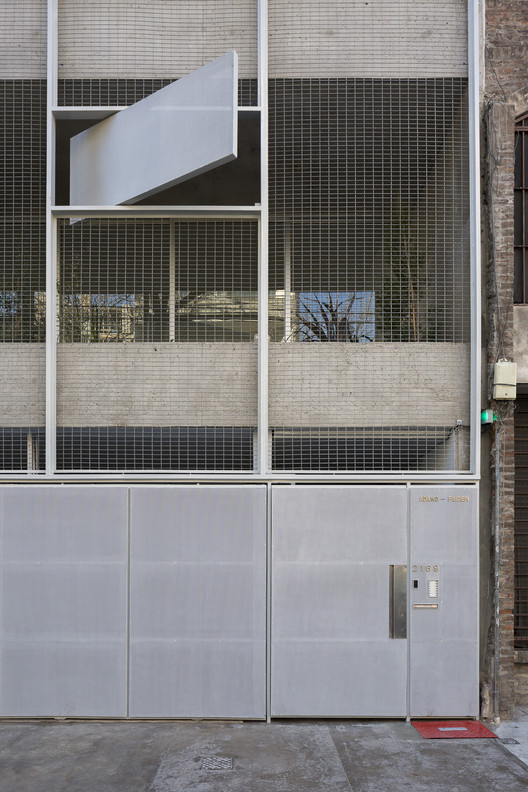House in Byoubugaura Takeshi Hosaka
2014-10-28 01:00
架构师提供的文本描述。横滨的一个居民区规划了一座地下室和地面以上两层的房子,该住宅区的特点是群山起伏。这个占地60平方米的场地被南面和北面的现有房屋夹住了.在东侧,该网站面对一个3米高的挡土墙。从这些角度看,这个遗址起初看起来像是被周围的环境所掩埋。
Text description provided by the architects. A house with a basement and two floors above ground was planned in a residential area in Yokohama, which is characterized by rolling hills. The 60-square meter site is sandwiched by existing houses to the south and the north. On the east side, the site faces a 3m-tall retaining wall. In these ways, the site at first looked like it was buried by the surroundings.
© Koji Fujii / Nacasa&Partners
作为回应,设计试图将同样数量的光和风的部分拉到地下室和地面。每层楼都有相同的天花板高度。每层楼的楼板在外观附近弯曲,使每一层的窗户尺寸相同。当看到高楼时,同样的四扇滑动的窗户排列起来,仿佛表明这座房子有两层楼高,有三层楼高。
In response, the design sought to pull in an equal amount of light and wind in section to both the basement and the ground level. Each floor was given the same ceiling height. The slab on each floor was bent near the exterior to give the same window size in section to each floor. When looking at the elevation, the same four sliding windows line up as if to indicate that the house, with a height of a two-story building, is three stories tall.
在地下室,一间位于地下的房间里突然刮起一股风,从东方的窗户到西边的窗户。此外,家具的核心高度设定在板下300毫米,这样风就会在上面移动。混凝土的天花板,逐渐上升,邀请自然光到内部。在上升的天花板的尽头可以看到东侧斜坡的绿色。
In the basement, a wind unexpected in a room located underground travels from the window on the east to the window on the west. Moreover, the core height of the furniture was set at 300mm below the slab so that the wind would travel above it. The ceiling of the concrete, which gradually rise, invites natural light to the interior. The green of the slope on the east side can be seen at the end of the rising ceiling.
© Koji Fujii / Nacasa&Partners
在一楼,上升的楼层挡住了街道的视野,确保了隐私,同时也邀请了外面的光线和风。此外,东侧3米高的挡土墙散发出的压抑感被上升的地面巧妙地最小化,将目光投向了远处的绿色。卫生间的天花板使用Acryl,位于一楼的核心家具中,即使放在地板的中央,也允许自然光线进入。
On the first floor, the rising floor blocks view from the street and ensures privacy, while also inviting light and wind from outside. In addition, the oppressive feeling exuded by the 3m-tall retaining wall on the east side is skillfully minimized by the rising floor, directing the eye to the green that is beyond. An acryl was used for the toilet's ceiling, located in the core furniture of the first floor, allowing natural light to enter even though it is placed at the center of the floor.
二楼的斜坡逐渐提供了一个舒适的空间,仿佛复制了外面的小山。屋面板也轻微弯曲。这样做是为了防止收集在无栏杆屋顶上的雨水流入窗户。在中心收集的水通过南面墙上的狭缝到达地面。
The second floor gradually slopes to provide a comfortable space as if to replicate the hills outside. The roof slab is also slightly bent. This was done to prevent the rainwater that collects on the parapet-less roof from flowing to the windows. The water that is collected at the center travels to the ground through the slit on the southern wall.
© Koji Fujii / Nacasa&Partners
设计的目的是建造一栋有一层地下室和两层楼高的房子,在这两层楼中,地下和地面上的各个层次以一种平等的方式堆放在一起。然而,一旦框架在现场完成,每个人都开始称地下室为一楼,一楼为二楼,三楼为二楼。最后,我们不知道哪一层是哪一层,这给一所非常有趣的房子带来了生机,你在地上,而你却在地下。
The design sought to build a house with one basement floor and two stories above ground in which the levels underground and above ground are stacked in an equal way. However, once the framework was completed at the site, everyone began to call the basement the first floor, the first floor the second floor, and the third floor the second floor. In the end, we could not tell which floor was which, giving life to a very intriguing house in which you are above the ground while you remain below it.
© Koji Fujii / Nacasa&Partners
 举报
举报
别默默的看了,快登录帮我评论一下吧!:)
注册
登录
更多评论
相关文章
-

描边风设计中,最容易犯的8种问题分析
2018年走过了四分之一,LOGO设计趋势也清晰了LOGO设计
-

描边风设计中,最容易犯的8种问题分析
2018年走过了四分之一,LOGO设计趋势也清晰了LOGO设计
-

描边风设计中,最容易犯的8种问题分析
2018年走过了四分之一,LOGO设计趋势也清晰了LOGO设计










































































































